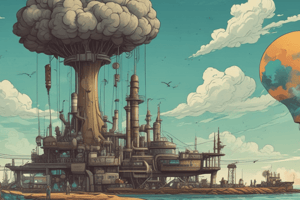Podcast
Questions and Answers
What is air pollution?
What is air pollution?
- Excessive sound that can harm human health and wildlife
- Excessive or obtrusive light that can harm human health and wildlife
- Contamination of water bodies by harmful substances
- Contamination of the atmosphere by harmful substances (correct)
What is a major cause of water pollution?
What is a major cause of water pollution?
- Industrial activities
- Agricultural activities
- Human activities
- All of the above (correct)
What is a potential health effect of pollution?
What is a potential health effect of pollution?
- Economic costs
- Climate change
- Acid rain
- Cancer (correct)
What is a solution to reduce pollution?
What is a solution to reduce pollution?
What is a major environmental effect of pollution?
What is a major environmental effect of pollution?
What is a type of pollution that can harm human health and wildlife?
What is a type of pollution that can harm human health and wildlife?
What is a way to transition to a more sustainable future?
What is a way to transition to a more sustainable future?
What is a key step in reducing pollution?
What is a key step in reducing pollution?
Flashcards are hidden until you start studying
Study Notes
Types of Pollution
- Air Pollution: contamination of the atmosphere by harmful substances, such as gases, particulates, and biological molecules.
- Water Pollution: contamination of water bodies, such as rivers, lakes, and oceans, by harmful substances.
- Soil Pollution: contamination of soil by harmful substances, affecting its fertility and productivity.
- Noise Pollution: excessive sound that can harm human health and wildlife.
- Light Pollution: excessive or obtrusive light that can harm human health and wildlife.
Causes of Pollution
- Industrial Activities: release of pollutants from factories, power plants, and other industrial processes.
- Vehicle Emissions: release of pollutants from vehicles, such as cars, trucks, and airplanes.
- Agricultural Activities: use of pesticides, fertilizers, and other chemicals that can contaminate soil and water.
- Waste Disposal: improper disposal of waste, such as littering and dumping.
- Human Activities: daily activities, such as cooking and heating, that release pollutants.
Effects of Pollution
- Human Health: respiratory problems, cancer, and other health issues.
- Environmental Damage: climate change, acid rain, and damage to ecosystems.
- Economic Impacts: loss of productivity, damage to infrastructure, and economic costs.
Solutions to Pollution
- Reduce, Reuse, Recycle: minimize waste, reuse products, and recycle materials.
- Use Clean Energy: transition to renewable energy sources, such as solar and wind power.
- Implement Pollution Controls: regulate industrial activities and enforce pollution laws.
- Increase Awareness: educate individuals and communities about pollution and its effects.
- Develop Sustainable Practices: adopt sustainable practices in agriculture, transportation, and daily life.
Types of Pollution
- Air pollution occurs when harmful substances like gases, particulates, and biological molecules contaminate the atmosphere.
- Water pollution happens when water bodies like rivers, lakes, and oceans are contaminated by harmful substances.
- Soil pollution occurs when soil is contaminated by harmful substances, affecting its fertility and productivity.
- Noise pollution is excessive sound that can harm human health and wildlife.
- Light pollution is excessive or obtrusive light that can harm human health and wildlife.
Causes of Pollution
- Industrial activities release pollutants from factories, power plants, and other industrial processes.
- Vehicle emissions release pollutants from vehicles, such as cars, trucks, and airplanes.
- Agricultural activities involve the use of pesticides, fertilizers, and other chemicals that can contaminate soil and water.
- Improper waste disposal, such as littering and dumping, contributes to pollution.
- Daily human activities, such as cooking and heating, release pollutants.
Effects of Pollution
- Pollution can cause respiratory problems, cancer, and other health issues.
- Environmental damage includes climate change, acid rain, and damage to ecosystems.
- Economic impacts of pollution include loss of productivity, damage to infrastructure, and economic costs.
Solutions to Pollution
- Reduce, reuse, and recycle to minimize waste, reuse products, and recycle materials.
- Transition to renewable energy sources, such as solar and wind power, to reduce pollution.
- Implement pollution controls by regulating industrial activities and enforcing pollution laws.
- Increase awareness about pollution and its effects through education and community outreach.
- Adopt sustainable practices in agriculture, transportation, and daily life to reduce pollution.
Studying That Suits You
Use AI to generate personalized quizzes and flashcards to suit your learning preferences.




